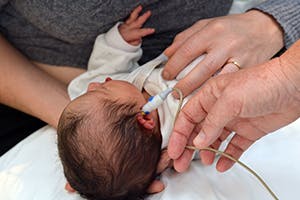The shape of your outer ear and ear canal affects your ability to hear and localize sounds. Microtia and atresia are congenital conditions that impact the shape of the ear and can cause hearing loss.
What is Microtia?
A birth defect that affects up to 7,000 babies every year, microtia is the underdevelopment of the outer ear or pinna.
Experts don’t know what causes microtia but believe it may occur during the mother’s first trimester of pregnancy when the outer and middle ear tissue begins to form. It’s also been linked to the use of certain medications, such as isotretinoin.
There are four grades of microtia:
Grade 1: The outer ear is fully formed but smaller than the normal size.
Grade 2: The outer ear is partially formed and the ear canal is narrow.
Grade 3: The outer ear is not fully formed but has a small cartilaginous structure or earlobe. There is no external ear canal.
Grade 4: There is no outer ear structure.
What is Atresia?
Also referred to as aural atresia, this condition is defined by the underdevelopment, absence or closure of the ear canal. It is often present in people with microtia. In some cases, the ear bones and eardrum also don’t develop, so the ear canal cannot direct sound properly.
Do They Cause Hearing Loss?
Microtia and atresia can affect one ear (unilateral) or both ears (bilateral) and cause moderate to severe conductive hearing loss, which occurs when there’s a blockage or problem in the outer or middle ear. Because both conditions cause abnormal ear structures, sound signals are disrupted or blocked completely before reaching the auditory nerve.
People with microtia or atresia are also subject to ear infections. Frequent swelling and inflammation can cause permanent damage to the ear’s hair cells responsible for sending audio signals to the brain.
Treatment Options
Both conditions can be treated with surgery.
Microtia:
- Rib graft construction uses cartilage from the patient’s rib cage to create the outer ear structure.
- MEDPOR ear reconstruction involves using a plastic ear that’s covered with tissue from the patient’s body.
- Prosthetic ears can also be applied with magnets or adhesive.
Atresia:
- Patients may undergo procedures to create or widen their ear canal.
- Bone conduction hearing aids are also available for people with atresia.
Hearing Associates provides comprehensive hearing tests to all our patients. We also offer hearing aids to suit your hearing loss needs. Call 888-760-2032 or contact us online to schedule your appointment.


